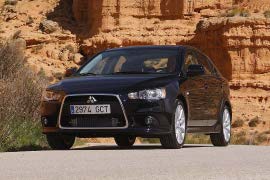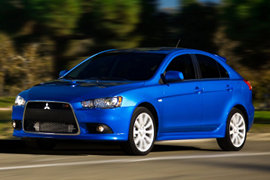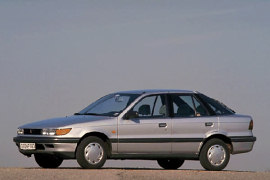MITSUBISHI Lancer Hatchback Models/Series Timeline, Specifications & Photos
First production year: 1988
Engines: Gasoline, Diesel
Body style: Hatchback
After the successful introduction of the 2007 Lancer generation, Mitsubishi tried its luck with a hatchback version unveiled in 2008.
Finally, the Japanese carmaker could use the Lancer nameplate globally. Before the 2007 version, it had to use Carisma on the European market, where it was a very appreciated car, but the name was not the one expected by its fans. Since the car was not available as a station wagon, the Japanese carmaker introduced a hatchback named Sportback.
It featured the same fresh look with a prominent trapezoidal grille and two angular headlights. Mitsubishi's designers extended the sharp lines on the sides over the bodywork. In the rear, behind the rear, doors, Mitsubishi's designers made a different C-pillar with a sloped liftgate in the back. They also redesigned the taillights.
Inside, the dashboard was clean with two-round clusters on the dashboard. Depending on the option, an infotainment system with Bluetooth connectivity, a navigation system, and a USB aux was available. In the back, the carmaker installed a 60/40 split-folding rear bench which increased the trunk size from 344 liters (15.14 cu-ft) to 1,349 liters (47.64 cu-ft)
The Lancer was available with various engines, starting with a 110 hp 1.5-liter naturally aspirated engine. Another 1.8-liter was available. Since the European customers asked for diesel engines, Mitsubishi installed a VW-supplied 2.0-liter TDI unit. On top of that, Mitsubishi offered a special version named Ralliart, which was a de-tuned Lancer Evolution with an all-wheel-drive and automatic (dual-clutch) gearbox.
Mitsubishi's motorsports division Ralliart worked on the hatchback version of the Lancer's ninth generation, offering a well-balanced package between a sports car and a family vehicle.
The Japanese automaker introduced the hatchback for the Lancer as a family-oriented vehicle, but the car's design didn't impress too much. In addition, the world financial crisis cut deep holes into the manufacturer's pockets, and Mitsubishi had to come up with something and survive the collapsing automotive market.
The car's front fascia was similar to the one provided by the Evolution X, but there were some differences between them. At the front, the Ralliart version featured a small red badge on the broad black grille. Unlike its X-sibling, it didn't feature a silver horizontal slat on the bumper area. The car's profile, with its raked-forward windscreen, abruptly ended the vehicle, not in the most elegant way. Yet, the Ralliart version managed to save things a little by adding a massive roof spoiler on top of the tailgate.
Inside, the cabin was designed mostly for comfortable yet sporty rides. There were no sports seats on the Ralliart, but the high-bolstered ones did provide adequate side support. In addition, the center console hosted the automatic transmission lever instead of the six-speed manual stick. Last but not least, the carmaker added paddle shifters behind the steering wheel. Like its non-Ralliart sibling of the Lancer Sportback, this sportier version also featured a split-folding rear bench.
Under the hood, Mitsubishi's motorsports department installed the same inline-four, turbocharged gasoline engine featured on the Evo X, but with fewer ponies. It was paired with a six-speed automatic (dual-clutch) gearbox that sent the power in all corners. Yet, the transmission was not as evolved as the one provided for the Evolution X. However, it still featured a rear limited-slip differential and an adaptive center diff.
MITSUBISHI Lancer Sportback Ralliart 2.0 MIVEC Turbo 6AT (240 HP)
Mitsubishi introduced the third generation of the Lancer in 1998, and it made it available in three bodywork versions: sedan, hatchback, and station wagon.
While the sedan was also produced and sold under different badges and made a successful carer, the hatchback was somehow overshadowed. Yet, it was a practical solution for those who needed a larger vehicle but didn't want a long-roof, classic station wagon. Moreover, the hatchback provided a lot of room in the luggage compartment and also ease of loading and unloading, thanks to the large tailgate.
The front fascia resembled the same look as its hatchback sibling, with a narrow grille flanked by wide headlights and underlined by the black trim from the bumper. However, its corner-mounted turn signals offered a unique styling design, with an ascending look for its rear edges. On the apron, Mitsubishi made room for pair of small scoops and a larger, lower mounted grille. At the back, the racked-forward D-pillar that supported the rear windscreen forced the carmaker to install a third side window behind the C-pillars. At the back, the taillights were big enough to be clearly seen from a long distance.
Inside, Mitsubishi tried to offer a decent cabin. It even installed an adjustable steering column for height and reach, which was not that common in the late '80s. The front bucket seats were slim and lower on the car's floor, but that led to smaller legroom for the rear passengers. Still, the split-folding bench was good enough to carry three children or two adults, but with some sacrifices for the knee room.
Under the hood, Mitsubishi relied on a small engine range that offered between 60 hp and 136 hp, depending on the version.


